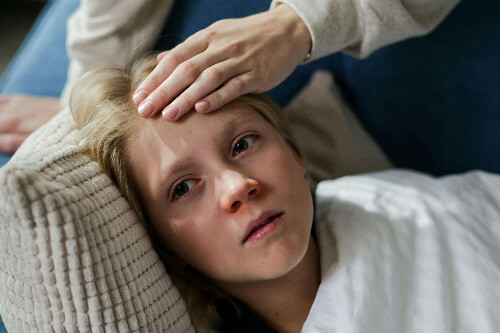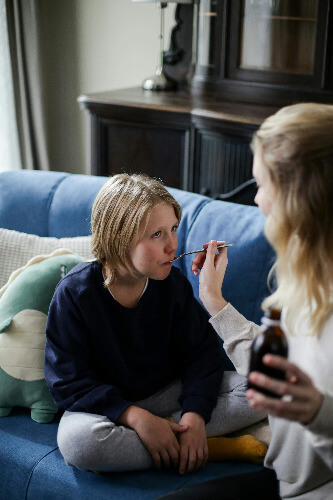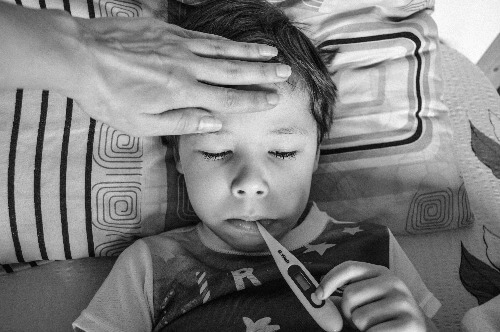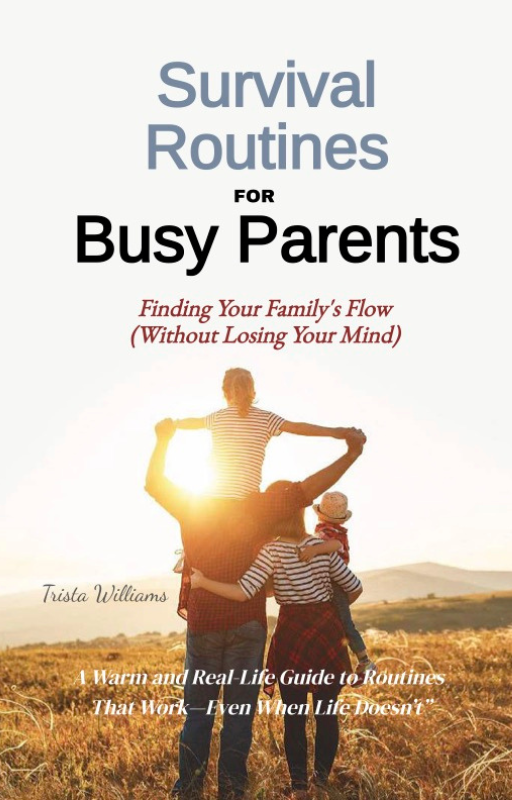What You Need to Know About the Most Common Childhood Illnesses
You always want to be sure your children are healthy and happy. But sometimes, despite your best efforts, illnesses can creep in. It can help you to be better prepared when you know how to handle the most common childhood illnesses with care and confidence.
1. The Common Cold
 Mom has her hand on child's forehead checking to see if they have a fever.
Mom has her hand on child's forehead checking to see if they have a fever.One of the most common childhood illnesses is the common cold. You are probably familiar with the telltale signs: cough, runny nose, sneezing.
Children who are in daycare or school are more likely to get colds because their immune systems are still developing.
- Symptoms: Runny or stuffy nose, sore throat, coughing, sneezing, mild fever, and body aches.
- Prevention: Frequent hand-washing, teaching children to cover their mouths when coughing or sneezing, and avoiding close contact with sick individuals.
- Treatment: Plenty of fluids, rest, and over-the-counter medications to relieve symptoms. Most importantly, keep your child comfy.
2. Ear Infections
Ear infections are another common childhood illness that can cause quite a bit of discomfort. They will sometimes come after having a cold or some other respiratory infection.
- Symptoms: Ear pain, trouble hearing, fluid drainage from the ear, irritability, and sometimes a fever.
- Prevention: Preventing colds through good hygiene can reduce the risk. Also, if you have an infant and are breastfeeding, you are lowering the risks of them getting ear infections.
- Treatment: Doctor visits are essential and antibiotics are often prescribed.
3. Stomach Flu (Gastroenteritis)
Stomach flu, or gastroenteritis, is a common childhood illness that causes inflammation of the stomach and intestines. It's usually caused by a virus, and while it's often mild, it can be quite unpleasant.
 Mom and child sitting on sofa, while mom give child medicine.
Mom and child sitting on sofa, while mom give child medicine.- Symptoms: Vomiting, diarrhea, stomach pain, and sometimes fever.
- Prevention: Good hand hygiene, especially after using the bathroom and before eating.
Ensuring that food is properly prepared and cooked can also help.
- Treatment: Keeping your child hydrated is crucial. Small sips of water, oral rehydration solutions, and rest are recommended.
Medical attention may be required in severe cases or if temperature is high.
4. Hand, Foot, and Mouth Disease
Another common childhood illness is hand, foot, and mouth disease. It primarily affects children under the age of five and is highly contagious but generally mild.
- Symptoms: Fever, reduced appetite, sore throat, and a rash on the hands, feet, and mouth.
- Prevention: Frequent handwashing and avoiding close contact with infected individuals.
- Treatment: There is no specific treatment, but pain relievers can help manage symptoms, and be sure that your child stays hydrated.
5. Chickenpox
Chickenpox used to be one of the most dreaded common childhood illnesses, but thanks to vaccines, it's less common now. They can still happen though, especially in unvaccinated children.
- Symptoms: Itchy rash that turns into fluid-filled blisters, fever, tiredness, and loss of appetite.
- Prevention: The chickenpox vaccine is highly effective in preventing the disease.
- Treatment: Calamine lotion, oatmeal baths, and over-the-counter medications can help relieve itching and discomfort. Keeping your child’s nails short can prevent skin infections from scratching.
6. RSV (Respiratory Syncytial Virus)
RSV is a common childhood illness that affects the respiratory tract. It can often be worse in infants and younger children.
- Symptoms: Runny nose, coughing, wheezing, and difficulty breathing.
- Prevention: Good hygiene practices, such as washing hands frequently and avoiding contact with sick individuals, can help reduce the risk.
- Treatment: Most cases are mild and can be managed at home with fluids, rest, and pain relievers. Severe cases may require hospitalization for supportive care, such as oxygen therapy.
 Mom has her hand on child's forehead and at the same time child is taking their own temperature.
Mom has her hand on child's forehead and at the same time child is taking their own temperature.7. Fifth Disease
Also known as “slapped cheek” disease due to the characteristic red rash on the face, fifth disease is a common childhood illness caused by the parvovirus B19.
- Symptoms: Bright red rash on the cheeks, followed by a lacy rash on the body, mild fever, and sometimes joint pain.
- Prevention: Good hygiene practices are essential.
- Treatment: The disease is usually mild and resolves on its own. The use of pain relievers can help manage symptoms, but you might want to talk to your doctor first.
8. Influenza (Flu)
Influenza, or the flu, is a common childhood illness that causes severe illness in kids. It's quite different from the common cold and can lead to serious complications.
- Symptoms: High fever, fatigue, cough, sore throat, body aches, and sometimes vomiting and diarrhea.
- Prevention: The flu vaccine is the best way to prevent the flu. Good hygiene practices also help.
- Treatment: Antiviral medications may be prescribed, especially if caught early. Rest, fluids, and pain relievers can help manage symptoms.
9. Scarlet Fever
Scarlet fever is a common childhood illness that arises from a strep throat infection. It’s characterized by a distinctive rash and needs prompt treatment.
ie. Scarlet fever doesn't always occur following strep throat. My daughter had it quite often, at least 5 times before age 6, and she never got scarlet fever.
- Symptoms: Red rash that feels like sandpaper, high fever, sore throat, and a “strawberry” tongue.
- Prevention: Good hygiene and avoiding contact with infected individuals.
- Treatment: Antibiotics are necessary to treat the infection. Over-the-counter meds. can help with pain and fever.
10. Conjunctivitis (Pink Eye)
Conjunctivitis, commonly known as pink eye, is a common childhood illness that causes inflammation to a certain part of the eye. It's highly contagious but usually mild.
- Symptoms: Redness in the white of the eye, swelling of the conjunctiva, itching or burning eyes, and discharge.
- Prevention: Good hand hygiene, avoiding touching the eyes, and not sharing personal items like towels.
- Treatment: Bacterial conjunctivitis may require antibiotic eye drops. Viral conjunctivitis usually resolves on its own. Keeping the eyes clean and using warm compresses can help relieve discomfort.
How You Can Support Your Child Through Illnesses
 Picture of thermometers and pills in addition to some fruits.
Picture of thermometers and pills in addition to some fruits.Although it can be somewhat demanding to care for a sick child, when you know how to support and comfort them it can make a big difference.
Keep Them Comfortable: Ensure your child gets plenty of rest. Create a cozy, calm environment where they can relax.
Hydration is Key: Offer plenty of fluids, like water, herbal teas, and soups. Don’t let them get dehydrated otherwise the symptoms will only worsen.
Nutritious Foods: Encourage them to eat small, nutritious meals. Foods like bananas, rice, applesauce, and toast can be gentle on the stomach.
Follow Doctor's Advice: Always consult with your pediatrician if you're unsure about symptoms or treatments. Doctor’s will offer you guidance that is suitable just for your child’s needs.
- Hygiene Practices: Teach your child the importance of good hygiene to prevent the spread of illnesses. Make handwashing fun by singing a song or using colorful soaps.
When to Seek Medical Attention for these Common Childhood Illnesses
While many common childhood illnesses are mild and can be managed at home, it's important to know when to seek medical attention.
If your child has difficulty breathing, persistent high fever, severe pain, or dehydration, it's time to call the doctor.
Being familiar with the most common childhood illnesses allows you to handle these situations calmly and effectively.
Kids will get sick on occasion, with the right care and support they will be back to their energetic selves in no time.
Trust your instincts and never hesitate to reach out for professional medical advice when necessary. Your child's health and well-being are always your top priority.
IMPORTANT NOTE: You may often turn to the internet to get advice on how to deal with your child's illness. I did more than once.
I get it, however, the internet is not your final answer, especially if you feel that there is something serious going on with your child. Your doctor is, so consider visiting them as soon as possible if you are the least bit concerned.






















New! Comments
Have your say about what you just read! Leave me a comment in the box below.